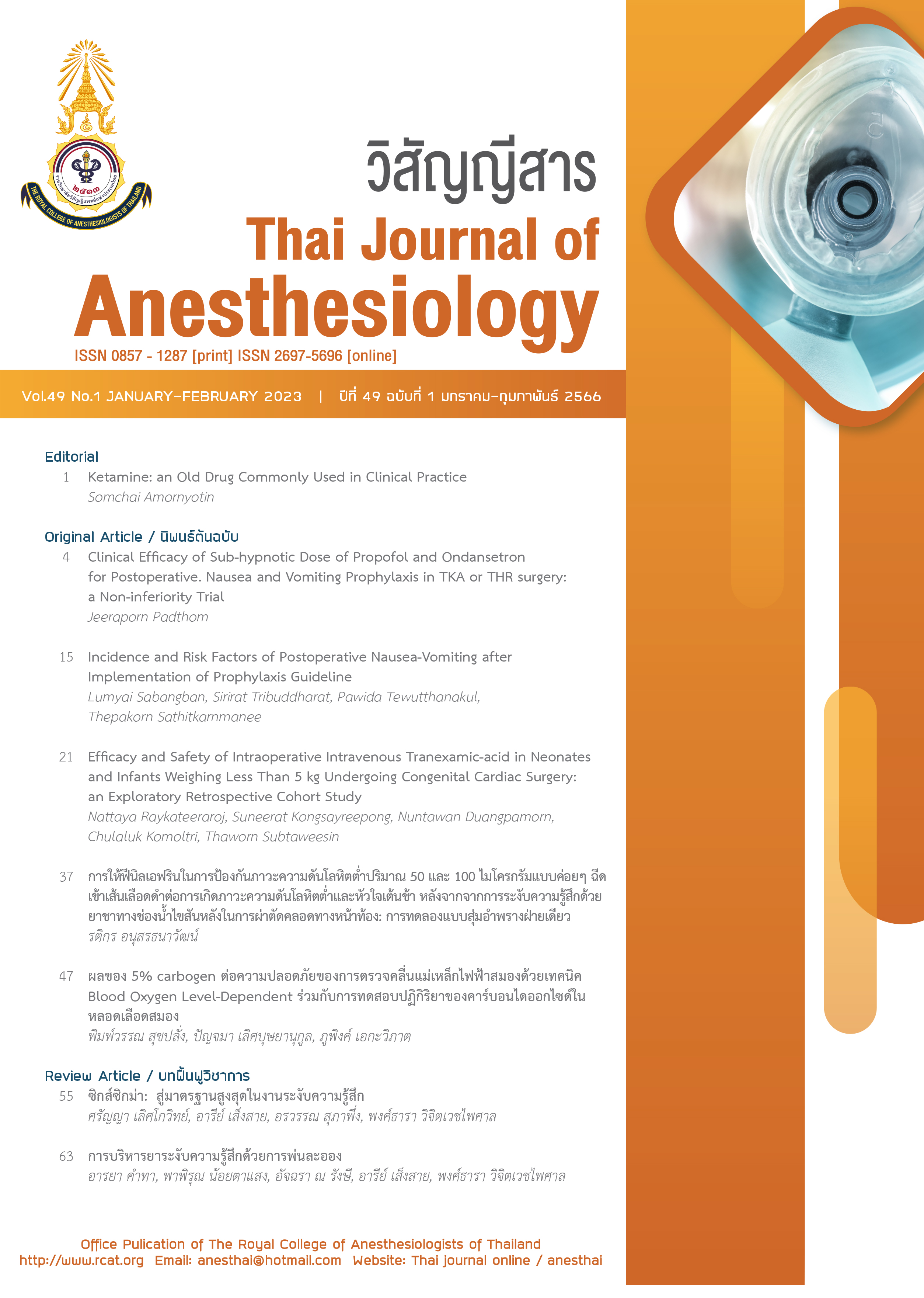Effect of 5% Carbogen on Patient Safety during Blood Oxygen Level-Dependent Magnetic Resonance Imaging with Cerebrovascular Carbon Dioxide Reactivity Test
Main Article Content
Abstract
Introduction: Preoperative evaluation andseverity assessment of cerebrovascularinsufficiency using the blood oxygen level-
dependent MR imaging (BOLD MRI) technique with the cerebrovascular reactivity test (CVR) using inhale carbogen gas is a new method in Thailand. There is a lack of information on the response of end-tidal carbon dioxide (ETCO2), the success of the examination, problems, and safety during the examination.
Materials and Methods: This study is a descriptive observational study in outpatients who underwent a BOLD MRI with CO2 reactivity test at the Neurological Institute of Thailand.
Results: Twenty-nine patients, 41 BOLD MRI with CVR test. Patients with Moya-Moya disease are frequently undergoing BOLD MRI with CVR test. At all intervals of inhaled carbogen, only the ETCO2 value was significantly changed compared with the initial ETCO2 value. During the examination, no complications were found.
Conclusions: The BOLD MRI with CO2 reactivity test is safe. However, the anesthesiologist should understand the principle of cerebrovascular reactivity and select the proper equipment to prepare for the examination.
Article Details

This work is licensed under a Creative Commons Attribution-NonCommercial-NoDerivatives 4.0 International License.
References
Fukui M. Guidelines for the diagnosis and treatment of spontaneous occlusion of the circle of Willis (‘moyamoya’ disease). Research committee on spontaneous occlusion of the circle of Willis (moyamoya disease) of the Ministry of Health and Welfare, Japan. Clin Neurol Neurosurg. 1997;99(Suppl2):S238-40.
Illuminati G, Calió FG, Papaspyropoulos V, Montesano G, D’Urso A. Revascularization of the internal carotid artery for isolated, stenotic, and symptomatic kinking. Arch Surg. 2003;138:192-7.
Gore JC. Principles and practice of functional MRI of the human brain. J Clin Invest. 2003;112:4-9.
Lekprasert V, Kamnerdthong C. Correlation of end-tidal Measurement to arterial PaCO2 during CO2 inhalation for cerebrovascular reactivity (CVR) test. Thai J Anesthesiol. 2014;40:148-9.
Bornstein NM, Gur AY. Cerebral vasomotor reactivity and carotid occlusive. Acta Clin Croat. 2006;45:357-64.
Kastrup A, Krüger G, Neumann-Haefelin T, Moseley ME. Assessment of cerebrovascular reactivity with functional magnetic resonance imaging: comparison of CO2 and breath holding. Magn Reson Imaging. 2001;19:13-20.
Dahl A, Russell D, Rootwelt K, Nyberg-Hansen R, Kerty E. Cerebral vasoreactivity assessed with transcranial doppler and regional cerebral blood flow measurements: dose, serum concentration, and time of the response to acetazolamide. Stroke. 1995;26:2302-6.
Zimmermann C, Haberl RL. L-Arginine improves diminished cerebral CO2 reactivity in patients. Stroke. 2003;34:643-7.
Kalamangalam GP, Nelson JT, Ellmore TM, Narayana PA. Oxygen-enhanced MRI in temporal
lobe epilepsy: diagnosis and lateralization. Epilepsy Res. 2012;98:50-61.
Sleight E, Stringer MS, Marshall I, Wardlaw JM, Thrippleton MJ. Cerebrovascular reactivity
measurement using magnetic resonance imaging: a systematic review. Front Physiol. 2021;12:643468.
Fierstra J, Sobczyk O, Battisti-Charbonney A, et al. Measuring cerebrovascular reactivity: what
stimulus to use? J Physiol. 2013;591:5809-21.
Liu P, Hebrank AC, Rodrigue KM, et al. A comparison of physiologic modulators of fMRI signals. Hum Brain Mapp. 2013;34:2078-88.
Riecker A, Grodd W, Klose U, et al. Relation between regional functional MRI activation and vascular reactivity to carbon dioxide during normal aging. J Cereb Blood Flow Metab. 2003;23:565-73.
Kastrup A, Dichgans J, Niemeier M, Schabet M. Changes of cerebrovascular CO2 reactivity during normal aging. Stroke. 1998;29:1311-4.
Bakker SLM, de Leeuw FE, den Heijer T, Koudstaal PJ, Hofman A, Breteler MMB. Cerebral haemodynamics in the elderly: the rotterdam study. Neuroepidemiology. 2004;23:178-84.
Kadoi Y, Hinohara H, Kunimoto F, et al. Diabetic patients have an impaired cerebral vasodilatory
response to hypercapnia under propofol anesthesia. Stroke. 2003;34:2399-403.
Young WL, Prohovnik I, Ornstein E, Ostapkovich N, Matteo RS. Cerebral blood flow reactivity to changes in carbon dioxide calculated using end-tidal versus arterial tensions. J Cereb Blood Flow Metab. 1991;11:1031-5.
Yezhuvath US, Lewis-Amezcua K, Varghese R, Xiao G, Lu H. On the assessment of cerebrovascular reactivity using hypercapnia BOLD MRI. NMR Biomed. 2009;22:779-86.
Wise RG, Pattinson KTS, Bulte DP, et al. Dynamic forcing of end-tidal carbon dioxide and oxygen applied to functional magnetic resonance imaging. J Cereb Blood Flow Metab. 2007;27:1521-32.
Ainslie PN, Duffin J. Integration of cerebrovascular CO2 reactivity and chemoreflex control of breathing: mechanisms of regulation, measurement, and interpretation. Am J Physiol Regul Integr Comp Physiol. 2009;296:R1473-95.
Golanov EV, Reis DJ. Oxygen and cerebral blood flow. In: Primer on Cerebrovascular Diseases, Welch KMA, Reis DJ, Weir B, Caplan LR, Siesjö BK, editors. Academic Press. 1997;p58-60.
Watson NA, Beards SC, Altaf N, Kassner A, Jackson A. The effect of hyperoxia on cerebral blood flow: a study in healthy volunteers using magnetic resonance phase-contrast angiography. Eur J Anaesthesiol. 2000;17:152-9.
Spano VR, Mandell DM, Poublanc J, et al. CO2 blood oxygen level-dependent MR mapping of cerebrovascular reserve in a clinical population: safety, tolerability, and technical feasibility. Radiology. 2013;266:592-8.
Taylor NJ, Baddeley H, Goodchild KA, et al. BOLD MRI of human tumor oxygenation during carbogen breathing. J Magn Reson Imaging. 2001;14:156-63.
Matta BF, Lam AM, Strebel S, Mayberg TS. Cerebral pressure autoregulation and carbon dioxide reactivity during propofol-induced EEG suppression. Br J Anaesth. 1995;74:159-63.

